 |
||
|
||
| ||
Summer traditionally brings a lot of concern and problems to owners
of PCs because of the increased temperature of system components and possible
negative consequences of their underperformance.
A closer lookAt first sight the Volcano 11+ cooler looks attractive: it sports a copper bonded-fin heatsink measuring 70x65x30 mm with good fin parameters (the fin is just 0.2 mm thick), a powerful fan, 80x80x25 mm, equipped with the temperature control system, and a 6-pin mounting system with a standard hold-down pressure.
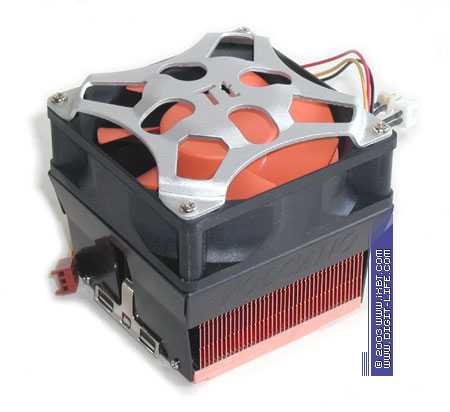 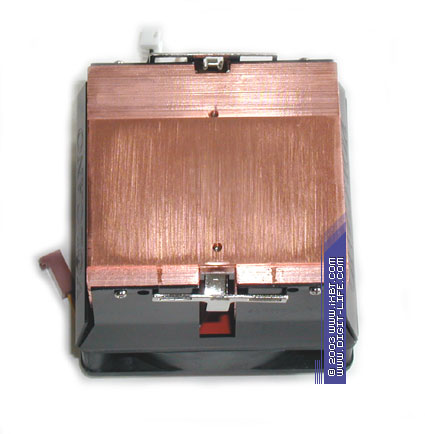 The accessory pack is rich of fashionable tools for fan rotation regulation and control. There are two rheostats which let you manually change the impeller speed from 1800 to 5300 rpm. One of them can be installed in the rear part of the PC case instead of expansion cards' brackets, and the other which is compatible with Thermaltake Xaser cases can be tucked in front instead of the bracket for 5.25" bays. There is also a thermal probe which can be connected to the fan to enable the automatic thermal control system (the fan regulates the impeller speed from 1500 to 5000 rpm in the temperature range from 20 to 55°C).
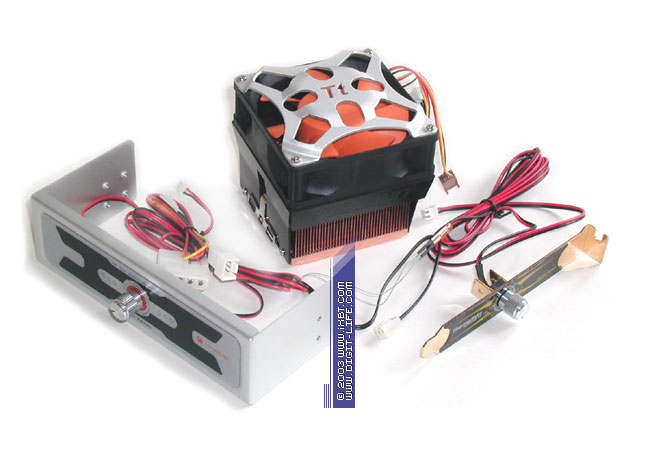 The Volcano 11+ looks like a modified superposition of two previous models - Volcano 7+ and Volcano 9; the developers say that it has absorbed the best ideas from both.
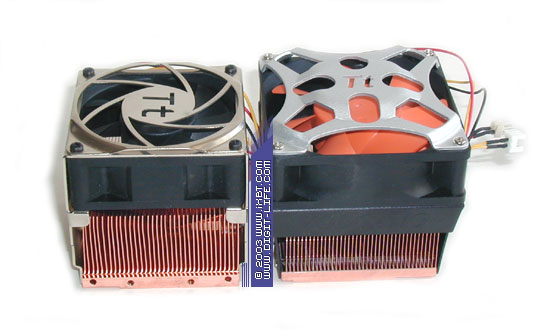 No secret that the Volcano 7+ was very weighty in spite of its good thermal effectiveness, and sometimes it was even dangerous for processor cores and sockets. That was the guilt of the heavy copper heatsink based on the skived-fin technology that could get minimal thermal resistance only at the expense of greater weight/size parameters. Obviously, the guys at Thermaltake decided to change it in the Volcano 11+. They used an alternative bonded-fin technology which allows making quite effective coolers. As a result, they developed a heatsink similar to the Volcano 7+ in size but being almost twice as light and having thinner fins.
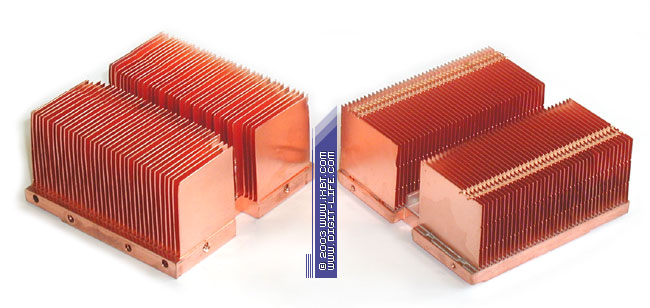 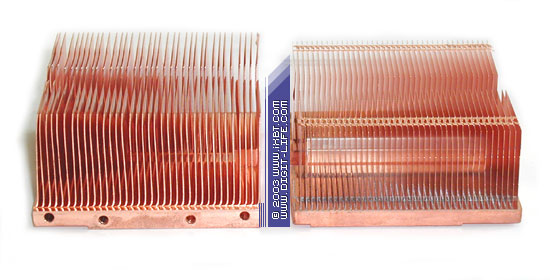 But some downsides are also noticeable. Instead of soldering used successfully in the bonded-fin products (Molex 37256, Evercool CUD-725 coolers) the finning in the Volcano 11+ holds on the base with ordinary thermal glue. It might badly affect the heatsink's thermal effectiveness (the contact thermal resistance of such joint is usually considerable).
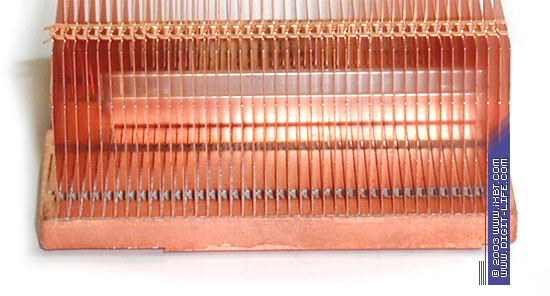 But taking into account the positive impression of the Molex 37165 coolers where the outer fins were attached to the copper core with thermal glue as well, we hope the results will be positive in this case too. However, it's still unclear why they used glue instead of soldering especially because the latter is a simpler and economically beneficial method for rectangular bonded-fin heatsinks. Such Thermaltake's solution looks strange for the company's tight-fisted nature. The Volcano 11+ inherits from the Volcano 9 the fan and the mount. The latter is entirely the same - a 6-pin construction which can't be installed without a screwdriver, but the hold-down pressure is normal. The fan (Everflow R128025BUT) differs only in color: it's black instead of orange. In all other respects, it uses the same advanced rotation management, an aggressive impeller design, two frictionless bearings, and high current consumption that goes along with the high rotational speed.
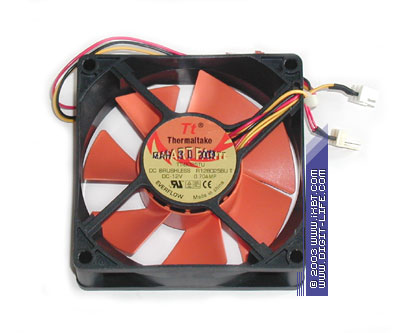 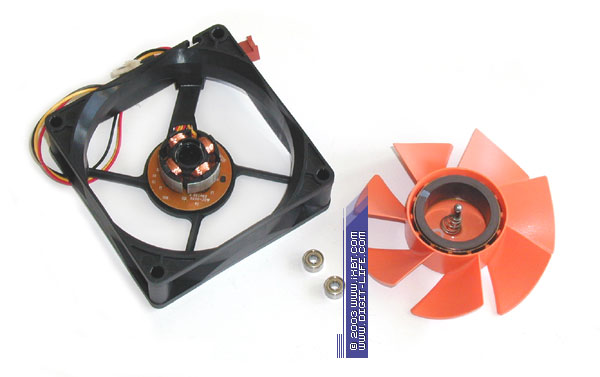 So, the first impression of the Volcano 11+ is quite pleasant. Now let's see how it works. Practical researchUnfortunately, the installation procedure wasn't that simple. It seems that the "parents" of the Volcano 11+ miscalculated the geometry of the fan's fixer (which also serves as a heatsink's cover): its dimensions do not match those of the mounting clip, and it's very difficult to handle the mounting device. If you don't have any experience in dealing with Thermaltake's products, the installation may turn into hellish tortures. :) With the default settings (5300 rpm without external regulators) the Volcano 11+ had pretty good thermal effectiveness - it was just a bit worse than those of the leaders, but the noise level was so high that I couldn't stand it even half a minute. It made unbearable 60 dBA. Even headphones with extremely heavy music wouldn't help it. The noise level was acceptable only at the speed of 3600 rpm and lower. But thermal effectiveness in that case was drastically low. When the fan was set to 3600 rpm (the middle point of the rheostats), the cooler had an acceptable performance level, but at 1800 rpm the score was awful: the Volcano 11+ could be compared only to primitive budget models. But the noise level even at such speeds wasn't that good. It worked quieter but its nature changed: the aerodynamic component was actually replaced with the mechanical noise coming from the bearings and the electrical noise of the AC electronic motor which does get on nerves even if the sound pressure is not great. The additional analysis has proved the nonoptimal technological implementation of the Volcano 11+. It turned out that the heatsink has quite different temperatures in different points. With the free convection the temperature in the control points on the base and at the bottom of the fins differed by 20% (the Volcano 7+ has a much less difference). It means that such weak performance of the Volcano 11+ is caused by increased contact thermal resistance where the fins are attached to the base because of the poor thermalphysic characteristics of the glue used. As a result, the only ring-bouy is the powerful fan which in the default mode (5300 rpm) intensively blows air through the heatsink at the cost of high noise. But without such dope the heatsink lets the poor Volcano 11+ down and makes it an outsider. However, the idea was very interesting: a well-designed bonded-fin heatsink coupled with a low-noise fan, 80x80x25 mm, and a decent mounting system could result in a very good solution. This current realization, however, has a long way to go... TestsFor a start let's compare thermal effectiveness of the Volcano 11+ and some other coolers used in the today's tests. The testbed configuration was changed to reflect the modern situation in the sphere of AMD processors and cooling systems for Socket A. It is assembled on the ABIT KD7-S mainboard with the high-quality temperature monitoring system which allows us objectively estimate coolers' effectiveness and get reliable results. The AMD Athlon XP 3000+ is used a heat-loading component. Testbed:
The CPUBurn burnk7 utility is used to emulate the thermal load close to the maximum, and the Motherboard Monitor is used for temperature monitoring. Here are the test results: Diagram 1. Temperature
Note Diagram 2. Thermal resistance
The last go the noise measurement results (the technique is described in the
article Coolers noise characteristics and noise level measurement technique).
Diagram 3. Noise characteristics
Obviously, no comments are needed. Let's sum it up! ConclusionThe idea the Thermaltake Volcano 11+ is based on is pretty good, and a lot of features are realized (though if the fan were less noisy, all those features would be actually unnecessary), but the outcome is very disappointing. The cooler is raw and unprepared for the tough tests in the systems based on high-performance AMD processors. So, the Thermaltake Volcano 11+ will hardly be of much interest for demanding PC enthusiasts and isn't worth our attention either.
Vitaly Krinitsin (vit@ixbt.com)
Write a comment below. No registration needed!
|
Platform · Video · Multimedia · Mobile · Other || About us & Privacy policy · Twitter · Facebook Copyright © Byrds Research & Publishing, Ltd., 1997–2011. All rights reserved. |